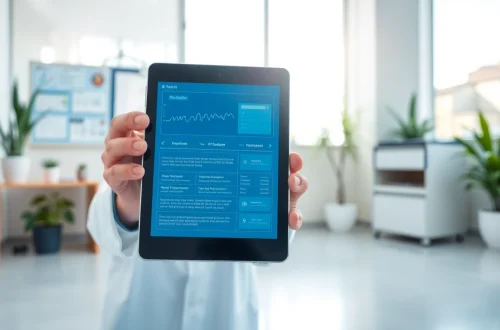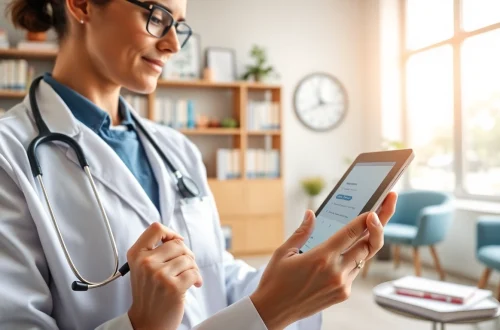Understanding Eprescribing and Its Benefits
In an age where technology transforms every facet of our lives, the healthcare sector is no exception. Eprescribing, or electronic prescribing, is an increasingly common practice that enhances the accuracy and efficiency of the prescription process. By utilizing free eprescription apps, healthcare providers can seamlessly interact with patients and pharmacies, facilitating a more streamlined medication management system.
What is Eprescribing?
Eprescribing refers to the electronic generation, transmission, and filling of medical prescriptions. This process eliminates the need for handwritten prescriptions, allowing prescribers to send prescriptions directly to a pharmacy through secure digital networks. Eprescribing is not only about sending a prescription but also involves integrating prescription data with patient records, increasing efficiency, and reducing errors.
The Importance of Eprescribing in Healthcare
The significance of eprescribing in modern healthcare cannot be overstated. First, it reduces the chances of prescription errors that might occur due to illegible handwriting or miscommunication between the patient and the pharmacist. Next, it allows healthcare providers to easily check for drug interactions, allergies, and patient medication history, leading to better clinical decisions. Moreover, it supports enhanced coordination among various healthcare providers, improving overall patient care.
Advantages of Free Eprescription Apps
Free eprescription apps have democratized access to this vital technology for healthcare providers of all sizes. Some of the primary advantages include:
- Cost Savings: Free apps eliminate the financial barrier, making it accessible for smaller practices and independent practitioners.
- Enhanced Efficiency: The ability to transmit prescriptions electronically decreases the time spent on phone calls to pharmacies, allowing for a quicker turnaround for patient medications.
- Improved Patient Safety: Integration with health records ensures that prescribers have access to the most current patient data, reducing the risk of adverse drug interactions and other complications.
- Convenience: Healthcare providers can write and renew prescriptions from anywhere, catering to the contemporary mobile lifestyle.
Top Features to Look for in Free Eprescription Apps
When choosing a free eprescription app, it’s essential to evaluate specific features that enhance user experience and ensure data security. Below are some critical attributes to consider.
User-Friendly Interface
A user-friendly interface is crucial for ease of navigation, reducing the learning curve for healthcare providers. A well-designed app should have intuitive menus, easy search functions, and quick access to essential features like prescribing history and patient records.
Integration Capabilities with Existing Systems
Seamless integration with Electronic Health Records (EHRs) is vital. The selected eprescribing app should easily integrate with existing healthcare management systems, minimizing disruptions and ensuring that both patient records and prescription data are cohesive and up-to-date.
Patient Communication Tools
Effective communication between healthcare providers and patients is paramount. Free eprescription apps should include tools for secure messaging to discuss medications, side effects, and any follow-up required, creating a more interactive and engaging healthcare experience for patients.
Compliance and Security in Eprescribing
Adhering to healthcare regulations and ensuring the protection of patient information is critical when utilizing any health technology, including eprescribing.
Understanding HIPAA Regulations
The Health Insurance Portability and Accountability Act (HIPAA) sets the standard for protecting sensitive patient information. Healthcare providers must ensure that the eprescribing app they choose complies with HIPAA regulations, safeguarding against data breaches and unauthorized access to patient data.
Data Security Measures in Free Eprescription Apps
In addition to HIPAA compliance, data security measures implemented by eprescribing apps should include encryption, two-factor authentication, and regular security updates. These protocols ensure that patient data remains secure while being transmitted and stored within the app.
Maintaining Patient Confidentiality
Confidentiality is a cornerstone of patient trust. Eprescribing apps must provide assurance that patient data is handled with the highest level of confidentiality, using secure channels for communication and storage to protect sensitive information adequately.
Implementation Strategies for Healthcare Providers
Implementing an eprescribing solution in a healthcare practice requires a thoughtful approach to ensure success and realize its full potential benefits.
Assessing Your Practice Needs
The first step is a thorough assessment of your practice’s specific needs. Factors such as the volume of prescriptions, patient demographics, and existing technology tools should guide the selection of an eprescribing app that best aligns with your operational requirements.
Training Staff on New Technologies
Once an appropriate app is selected, investing in comprehensive training for staff is vital. This should encompass not only the technical usage of the app but also best practices for patient engagement, data security, and compliance. Training can significantly enhance the transition process and promote user confidence.
Monitoring Performance and Feedback
After implementation, ongoing monitoring of the app’s performance is essential. Gather feedback from both staff and patients to evaluate usability and effectiveness. Regular reviews can help identify areas for improvement and ensure that the app continues to meet the evolving needs of the practice and its patients.
Future Trends in Eprescribing Technology
As technology continues to evolve, several trends are shaping the future of eprescribing, making it more efficient and user-friendly.
Artificial Intelligence’s Role in Eprescribing
Artificial Intelligence (AI) is poised to revolutionize eprescribing by providing predictive analytics for potential medication interactions and suggesting personalized treatment plans based on individual patient data. AI can also streamline the prescribing process, reducing time spent on administrative tasks and allowing healthcare providers to focus on patient care.
Mobile Application Innovations
With the rise of mobile technology, innovations in mobile apps for eprescribing are likely to continue. Future applications may offer enhanced functionalities such as voice recognition for prescription input, advanced analytics for tracking patient adherence, and improved telehealth integration, making healthcare delivery more accessible.
The Future of Telemedicine and Eprescribing
As telemedicine gains traction, the synergy between telehealth and eprescribing will continue to flourish. Eprescribing tools will likely evolve to accommodate virtual consultations, ensuring that patients receive timely prescriptions after online appointments. This integration will not only enhance patient convenience but also improve overall health outcomes by ensuring that prescriptions are promptly filled.
In conclusion, free eprescription apps present an essential solution for modern Healthcare providers looking to enhance patient care, minimize errors, and streamline their prescribing process. By understanding the benefits, assessing needs, ensuring compliance, and keeping an eye on emerging trends, practitioners can position themselves for success in a rapidly evolving digital landscape.





